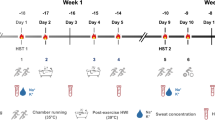Abstract
The aim of this study was to: (1) determine directly the energy cost of shuttle running (C Sh) and (2) compare it to the values indirectly estimated from kinematic data. C Sh over distances of ≈10 or ≈20 m was determined on 65 subjects (group 1) from gas exchange measurements over 155 trials, or indirectly estimated on 10 subjects (group 2) from the time course of the speed as follows. (1) The cost to accelerate from zero to peak speed was estimated assuming a 25 % efficiency and added to that of constant-speed running, as obtained on subjects of group 1. (2) Since (i) accelerated running on flat terrain is equivalent to running uphill at constant speed, on a slope dictated by the forward acceleration (di Prampero et al. in J Exp Biol 208:2809–2816, 2005), and (ii) the energy cost of running uphill is known, C Sh was obtained from the time course of the acceleration. C Sh increased with the average speed, at any given speed being significantly greater for the shorter distances; e.g., at ≈4 m/s over 10 m, it amounted to ≈14 J/(kg m), i.e., 3.5-fold larger than that at constant speed. The two indirect methods yielded results not significantly different from C Sh over the longer (≈20 m), but underestimated it over the shorter (≈10 m) distances. From our results, over ≈20 m C Sh can be obtained with sufficient accuracy from actual measurements of peak speed alone, thus, greatly simplifying the experimental procedure. The so-obtained data can then be utilized to assess the athletic status of any subject, as well as to plan appropriate training strategies.




Similar content being viewed by others
References
Bangsbo J (1994) Fitness Training in Football “a scientific approach” publisher August Krogh Institute, Copenhagen University
Bangsbo J (1996) Yo–Yo test. Ancona, Kells
Bangsbo J, Iaia FM, Krustrup P (2008) The Yo–Yo intermittent recovery test: a useful tool for evaluation of physical performance in intermittent sports. Sports Med 38(1):37–51
Buglione A, Lazzer S, Colli R, Introini E, di Prampero PE (2011) Energetics of best performance in elite kayakers and canoeist. Med Sci Sports Exerc 43(5):877–884
Cavagna GA, Komarek L, Mazzoleni S (1971) The mechanics of sprint running. J Physiol 217:709–721
Colli R, Buglione A, Introini E, D’Ottavio S (2007) L’allenamento intermittente tra scienza e prassi. SDS no. 72, pp 45–52
di Prampero PE (1981) Energetics of musclar exercise. Rev Physiol Biochem Pharmacol 89:143–222
di Prampero PE, Ferretti G (1999) The energetics of anaerobic muscle metabolism. Respir Physiol 118:103–115
di Prampero PE, Peeters L, Margaria R (1973) Alactic O2 debt and lactic acid production after exhausting exercise in man. J Appl Physiol 34(5):628–632
di Prampero PE, Fusi S, Sepulcri L, Morin JB, Belli A, Antonutto G (2005) Sprint running: a new energetic approach. J Exp Biol 208:2809–2816
di Prampero PE, Salvadego D, Fusi S, Grassi B (2009) A simple method for assessing the energy cost of running during incremental tests. J Appl Physiol 107:1068–1075
Iaia FM, Rampinini E, Bangsbo J (2009) High-intensity training in football. Int J Sports Physiol Perform 4(3):291–306
Léger L, Gadoury C (1989) Validity of the 20 m shuttle run test with 1 min stages to predict VO2max in adults. Can J Sport Sci 14:21–26
Léger LA, Lambert J (1982) A maximal multistage 20-m shuttle run test to predict VO2max. Eur J Appl Physiol 49:1–12
Léger LA, Mercier D, Gadoury C, Lambert J (1988) The multistage 20 meter shuttle run test for aerobic fitness. J Sports Sci 6:93–101
Margaria R, Cerretelli P, Aghemo P, Sassi G (1963) Energy cost of running. J Appl Physiol 18:367–370
Minetti AE, Ardigò LP, Saibene F (1994) Mechanical determinants of the minimum energy cost of gradient running in humans. J Exp Biol 195:211–225
Minetti AE, Moia C, Roi GS, Susta D, Ferretti G (2002) Energy cost of walking and running at extreme uphill and downhill slopes. J Appl Physiol 93:1039–1046
Nassis GP, Geladas ND, Soldatos Y, Sotiropoulos A, Bekris V, Souglis A (2010) Relationship between the 20-m multistage shuttle run test and 2 soccer-specific field tests for the assessment of aerobic fitness in adult semi-professional soccer players. J Strength Cond Res 24(10):2693–2697
Ramsbottom R, Brewer J, Williams C (1988) A progressive shuttle run test to estimate maximal oxygen uptake. Br J Sports Med 22:141–144
Zadro I, Sepulcri L, Lazzer S, Fregolent R, Zamparo P (2011) A protocol of intermittent exercise (shuttle runs) to train young basketball players. J Strength Cond Res 25(6):1767–1773
Author information
Authors and Affiliations
Corresponding author
Additional information
Communicated by David C. Poole.
Rights and permissions
About this article
Cite this article
Buglione, A., di Prampero, P.E. The energy cost of shuttle running. Eur J Appl Physiol 113, 1535–1543 (2013). https://doi.org/10.1007/s00421-012-2580-9
Received:
Accepted:
Published:
Issue Date:
DOI: https://doi.org/10.1007/s00421-012-2580-9




